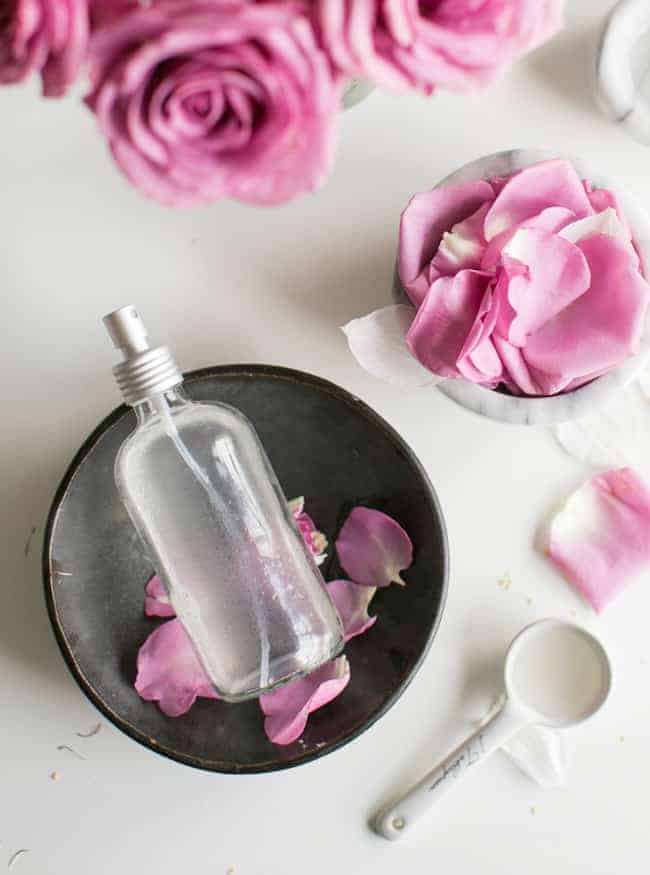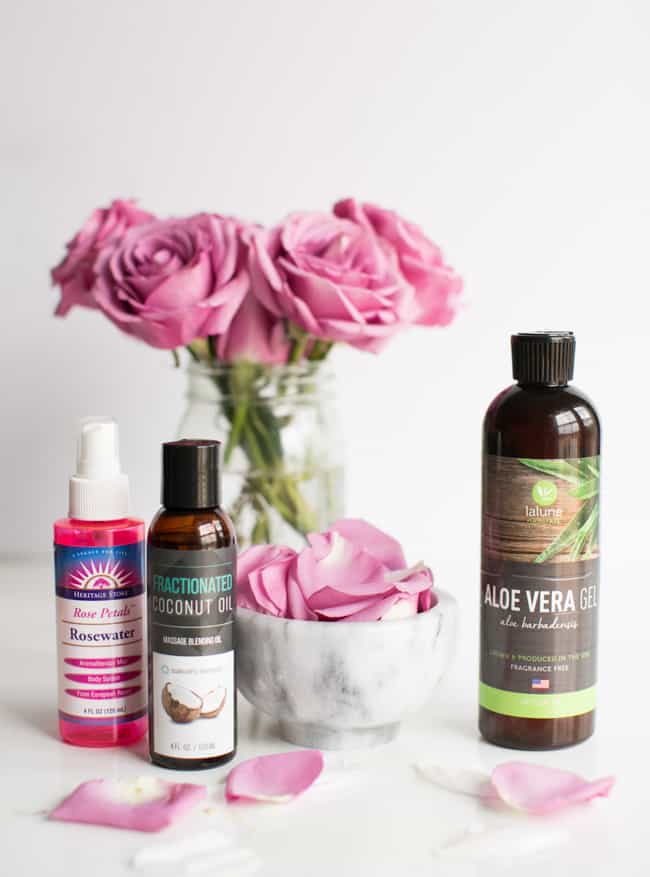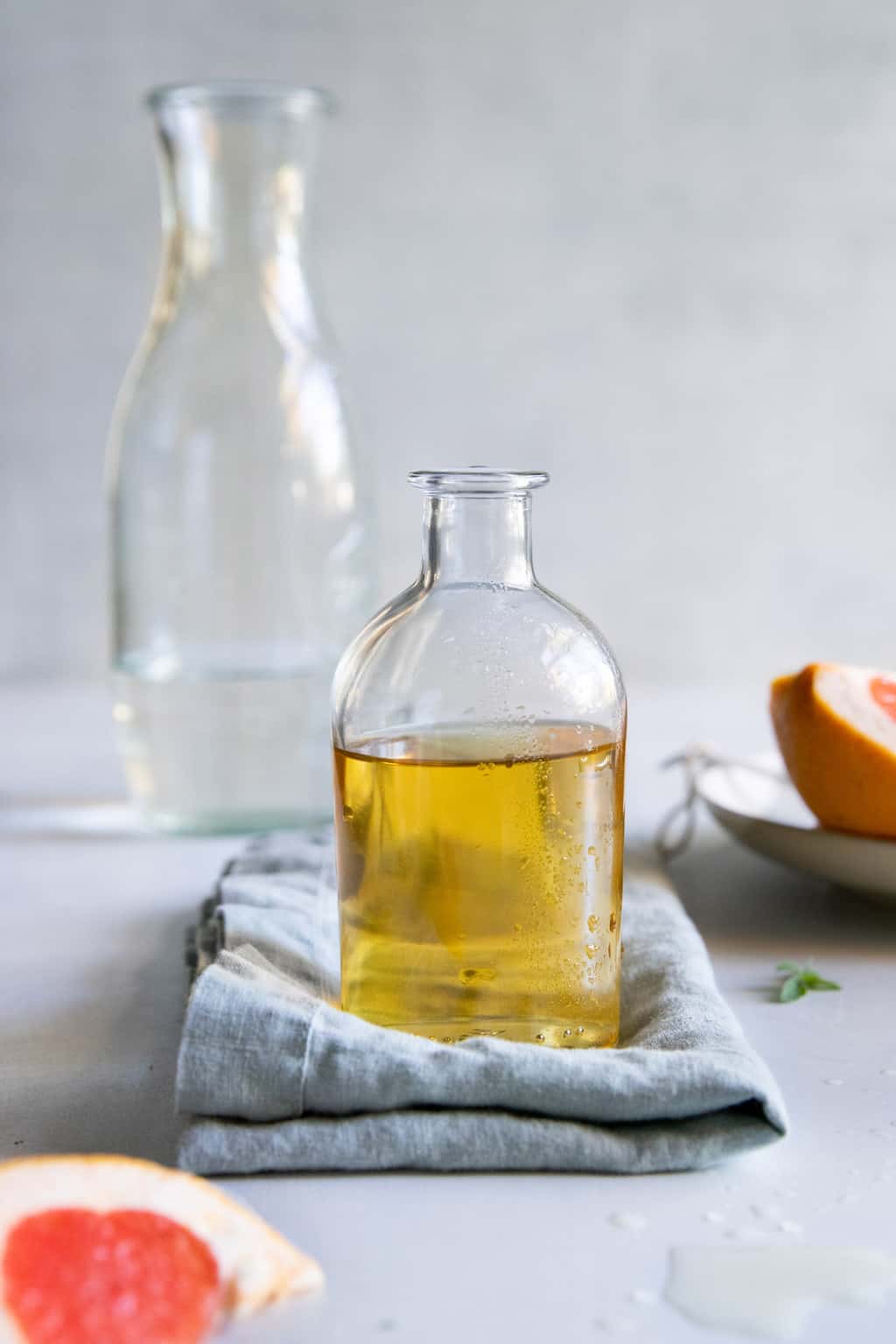If warm weather has turned your hair into a dry, unmanageable mess, then we’ve got the solution with this homemade anti-frizz spray. Use it on wet or dry hair to lightly condition and keep flyaways and frizz under control without weighing down your strands.

Homemade Anti-Frizz Spray
For a long time, I had conditioner-a-phobia. Definition: Refusing to use any conditioner based on the belief that it would weigh down my short, fine hair. (Yes, I might’ve made that up, but it’s totally real.)
Did this result in more volume? Yes. Because my hair was a dry, frizzy mess. At my last haircut, my strands got a deep conditioning, and the results were just short of miraculous. So much softness and shine!
My hair guy informed me that conditioner is not the enemy in the eternal quest for full, bouncy hair. His advice: go with a lightweight conditioner and don’t use it on the scalp. The ends of your hair need moisture and conditioning to lie flat and smooth—without frizz.
But sometimes, I need a little extra product to get my hair to look freshly salon-styled. That’s where this homemade anti-frizz spray comes in. Thanks to a few carefully selected ingredients, it does everything my hairdresser’s pro products do while also nourishing hair and smoothing strands. Plus, it clocks in at a fraction of the cost of a salon session.
Here’s how it works:
Aloe Vera Hair Benefits
I love this spray so much because it uses aloe instead of oil. Aloe vera is rich in vitamins, minerals, and enzymes [source] that make it especially good at moisturizing and volumizing your hair.
It’s an emollient that seals the hair’s cuticle, which prevents moisture from escaping. Aloe contains about 20 amino acids (the building blocks of our hair) [source], and the gel-like substance nourishes and strengthens static-prone hair.
I recommend using a natural aloe vera gel for the most nutrients (this one is my all-time favorite), but you can also use fresh aloe if you like. Simply harvest the gel and use it as recommended in the recipe below.
Just be forewarned; fresh aloe goes bad very quickly, so you should store your spray in the refrigerator and use it within a week. Feel free to halve the recipe if you can’t use up all your frizz spray in time.
Rosewater Hair Benefits
And then there’s rosewater, with its delicious scent. Rosewater conditions, adds shine, and gives you a bit of hair perfume. Feel free to spritz this on your face or any areas tender with sunburn. It’s incredibly soothing.
Coconut Oil Hair Benefits
Coconut oil has so many uses for your hair, and it’s part of this simple serum to calm down frizzy flyaways. We used fractionated coconut oil, so the spray stays in the liquid form, making it easier to use in a spray bottle.
You can even put coconut oil—or jojoba or argan oil—straight onto the ends of your hair. However, to avoid weighing down the hair, it’s best to start with a little bit of oil at a time until you get the look you want.
You can slowly add more product until it’s perfect, because it’s much harder to take too much product away.
How to Make Your Own Anti-Frizz Spray
Ingredients
- 2 tablespoons aloe vera gel (either fresh or store-bought is fine)
- 1–2 teaspoons fractionated coconut oil
- ½ cup rosewater
Add aloe vera, coconut oil, and rosewater together in a small bowl. Whisk to combine. With the help of a funnel, transfer the mixture into a spray bottle. Store in the refrigerator for 3–4 days if using fresh aloe vera and 7–10 days if using store-bought aloe.
How to Use a Smoothing Spray
This is how I use my homemade anti-frizz spray, but you may need to play around with it to see what works best for you.
1. Wash and condition your hair like usual.
2. Pat dry with a towel and comb your hair to get rid of tangles.
3. Spritz the anti-frizz spray on damp hair, then comb again. Feel free to use more or less spray, depending on your hair type.
4. Style as usual.
Note: Depending on your hair texture, you may have better luck applying this spray to dry hair. Simply style your hair as usual, then lightly spritz with anti-frizz spray. Run your hands over the hair to tame flyaways and smooth strands.
6 Ways to Get Rid of Frizzy Hair Naturally
Sometimes, your hair needs a little extra help when it comes to taming the frizz. This recipe is a good place to start, but if you’re still experiencing issues with frizzy locks, here are 6 things you can do to get rid of it once and for all:
Use a hair mask or hot oil treatment. Lack of moisture is one of the main reasons we get frizzy hair. To help replenish vital moisture, use a homemade hair mask or hot oil treatment weekly.
Use argan oil as a serum. Rub a teaspoon of argan oil between your hands and lightly run your hands through your hair. The oil should sink in, smoothing locks and cutting frizz.
Apply some hairspray. While hairspray won’t help boost your hair’s moisture content, it will help smooth down the hair shaft, making it appear less frizzy. If you want to make your own at home, just check out our sugar hairspray.
Say goodbye to plastic brushes. Sebum, which is normally stripped away from washing and styling, is your hair’s original anti-frizz serum. A natural bristle brush can help distribute sebum from the scalp along the hair shaft without increasing static.
Wash less often. Washing strips hair of its natural oils. To prevent this, wash your hair less often and use dry shampoo on the off days to keep it looking fresh. Combine this with using a natural brush to redistribute sebum and nourish locks.
Homemade Anti-Frizz Spray
Equipment
- Small bowl or measuring cup
- Funnel
- Spritz bottle
Materials
- 2 tablespoons aloe vera gel (or fresh aloe)
- 1–2 teaspoons fractionated coconut oil (or jojoba or argan oil)
- ½ cup rose water (or distilled water)
Instructions
- Add the ingredients into a bowl or measuring cup. Whisk well to combine and dissolve the aloe.
- Using a funnel, transfer the mixture to a spray bottle. Screw the cap on tight, and make sure to give the mix a good shake before each use.
Notes
References:
Sánchez M, et al. Pharmacological update properties of Aloe vera and its major active constituents. Molecules. 2020.
Surjushe A, et al. Aloe vera: a short review. Indian J Dermatol. 2008.
This post was medically reviewed by Dr. Jennifer Haley, a board-certified dermatologist with extensive experience in medical, cosmetic, and surgical dermatology. Learn more about Hello Glow’s medical reviewers here. As always, this is not personal medical advice, and we recommend that you talk with your doctor.
Photos by Susan Hudson
441









freecodesmarket.com says
Thanks dear for sharing this amazing recipe its good.
Samantha says
Can we use aloe Vera plant insides? And how long does it store? Do I need to keep in the fridge?
Kxchic says
Needed something for my long baby fine thick hair which has become extremely static lately.
This did absolutely nothing to help with the static electricity I was experiencing in my hair.
Ordered the exact same coconut oil, aloe vera and rose water suggested. Iam very pleased with the quality of said ingredients as they seems very high.
Even though this concoction didn't work for taming the static in my hair, it does however feel very nice and moisturizing for my skin. So this wasn't a total loss.
Omita says
Dear Ms. Stephanie Gerber
Thank you for your help..
But there are two points i would like to know.
1) how long can we store the Homemade Conditioning Anti-Frizz Spray, since the aleo-vera gel would not stay more than two days after its extracted from the plant.
2) Do we need to rinse after applying the conditioner or it acts like Hair Serum
Dr. Ume Kulsoom says
Hello.
I'm so desperately am in need of a conditioner for my dry frizzy hair! Gonna try this out!
But I wanted to know if this is a leave in conditioner, or we have to apply it after shower and rinse it?
Marla says
Thank you for this. My hair needs this badly. Summer is killing me!